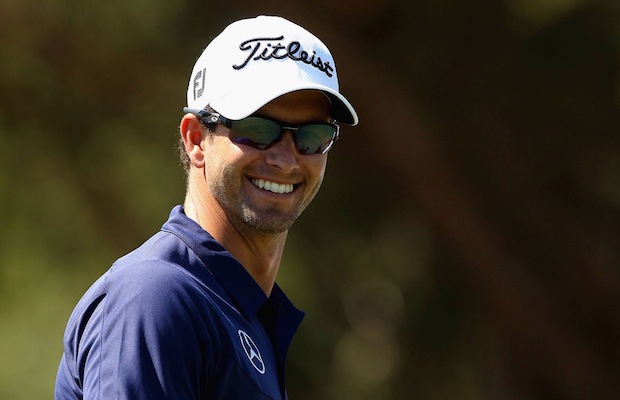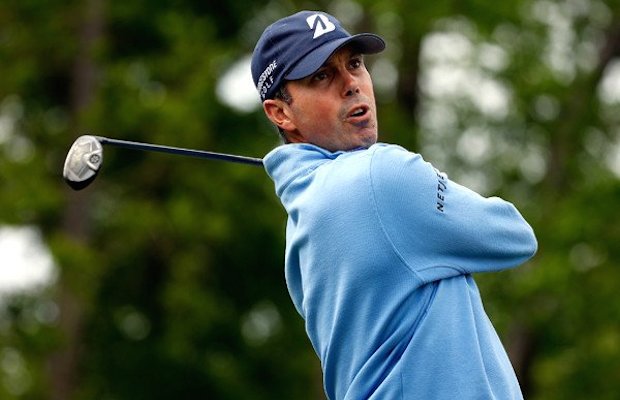Instruction
Fantasy Cheat Sheet: Shell Houston Open

Since 2007, the Shell Houston Open has been the springboard to the Masters. Normally played the week prior to the year’s first major, it is the last chance for someone to get to Augusta, and the only way to do so is to win.
The Golf Club of Houston (formerly Redstone Golf Club) in Humble, Texas, has been the host since 2003, and it appears to be yielding one of the strongest fields it has ever had. That’s primarily due to the Rees Jones design acting as an Augusta National prequel. And of the participants, there are 14 players who have combined to win 25 major titles, including five by Phil Mickelson, who is coming off a withdrawal from last week’s Valero Texas Open. Who knows if his oblique muscle strain was real or something to get him home a day earlier once he got far out of contention.
For Jimmy Walker, who played his college golf at nearby Baylor University, being in the field as a three-time PGA Tour winner, which was all accomplished this year, comes on the heels of a barely-made cut.
Many gamers are starting fresh after the Yahoo winter segment ended, and hopefully you’re holding onto a virtual trophy. But with a new segment now in the works, begin planning your strategies accordingly and don’t be afraid to play some hunches on a course that sets up for Masters prep. Here’s a look at some I’ll fool around with this week. It’s Risk, Reward, Ruin.
RISK
With such a strong field this week, season starts to be valued at this point in the year, and a new segment opening up, I want to take a deeper look at some golfers who are likely total hit-or-miss for one reason or another. I really like all five of the Risk picks below, but I will still be calculated in whatever gambles I take. Often that means pairing risk with reward so you don’t wind up with goose eggs on your scorecard and a bottle of Goose in your hands.
Steve Stricker
Last year, he played a limited schedule. This year by comparison makes Steve Stricker look a buddy who pulls his clubs out of the attic every June to go drink a sixer and lose 50 balls in the water. Of course, Stricker practices in the meantime, but he’s played but four events this season and one was match play where he got bounced in the first round. He won’t shoot himself in the foot this week, but the play of recent tournament play provides me trepidation he won’t tear up GCH either. When he was playing a lot, Stricker’s results were impressive. His last two outing were middle of the pack, but before came T4 (’11), T11 (’08), T9 (’07) and solo third (’06) results with one missed cut mixed in. You’d like to use him because he has so many starts available. This could be a good time.
Paul Casey
In 2009, Paul Casey reached third in the Official World Golf Rankings. In that year, he recorded his first PGA Tour victory at the Shell Houston Open, topping J.B. Holmes in a playoff, then later won the European Tour’s high-profile BMW PGA Championship. But also in that year, he suffered an injury, which slowed his ascent, before his game turned back the other way. His only Tour win is still in Houston, though he does have 12 European Tour and two Asian Tour wins to his credit. A T12 at the Honda Classic a month ago was a nice sign to his game, but he missed the cut at the Valspar and tied for 60th at the Arnold Palmer Invitational. He has missed his last two cuts at SHO, but I believe he’s nearer his 2009 form than that of his struggling play in more recent memory.
Hunter Mahan
This slot was a tie between Matt Kuchar and Hunter Mahan until Kuchar finally awoke from a semi-slumber and played well for three rounds at the Valero Texas Open. Kuchar will continue to play well, but Mahan needs a top-5 finish to get his year going. And since he withdrew during the final round of the Arnold Palmer Invitational with a hip injury, it’s a mystery to know what kind of golfer he’ll be this week. But with four top-10s this season and a win at the SHO in 2012, it’s not to say he can’t come out on top again. He’s contended a lot as evidence by T8 (’11), T6 (’09), T5 (’07) and T11 (’06) finishes, but he’s also sprayed in four missed cuts during a 10-year stretch.
Charles Howell III
Charles Howell III may be heading to Augusta this week, but the only way the hometown kid is making the Masters is by winning this week. He has six top-10s this season and he’s entering with a final-round 76 at the Arnold Palmer Invitational to remind him of missed opportunities to slide in using the OWGR. Fortunately for him, he’s played well at the SHO. Last year, tied for 10th, in 2011 he was T19. He’s 6 for 9 with a solo 17th in ’05 as his only other solid result. CH3 is a true risk pick with his last PGA Tour win coming in 2007.
Brian Davis
Davis enters this week with very little to show for his season thus far, outside a couple top-20s. A third-round 76 took him out of brief contention last week, but Davis has shined at the Shell Houston Open. He finished T6 last year with nothing to show for himself in the weeks preceding. In 2012, he finished T4. He’s 5 for 7 at SHO with a T7 in ’05 and a T14 in ’09. Davis is a good under-the-radar pick and in a great spot to use him in Golf Channel’s game.
REWARD
Up until Phil Mickelson withdrew from the Valero Texas Open, I had him pegged to be in the Reward category. This will be the 10th time he’s teed it up at the SHO, and he won in 2011. But now, I don’t have anywhere to slot him. I guess, technically, he’s a Risk, but I’m not even close to considering him. He’s also not been so bad that he’s Ruin either. Lefty is in some weird golf purgatory right now, which is not where you want your game to be heading into Augusta. So for now, here are five I especially like to tame Houston’s fast-paced greens. Apologies to the many elite golfers not named.
Henrik Stenson
Coming off a T5 at the Arnold Palmer Invitational, Stenson enters GCH as a strong favorite thanks to a T3 finish in 2009 and a T2 last year. On this course, hitting greens in regulation will be a big key to success, which is what Stenson did so well at Bay Hill. His GIR sits at just below 70 percent, which would place him in the top 25 on Tour if he qualified. If he hits greens this week, look out.
Rory McIlroy
Outside of Adam Scott, who’s not in the field this week before defending his Masters title, you could make a strong case for McIlroy being the best player in the world. His play this season backs that up this season with a win at the Emirates Australian Open and a loss in a playoff at The Honda Classic. On the European Tour, he’s had a T9 at the Dubai Desert Classic and a T2 at the Abu Dhabi HSBC Championship. McIlroy’s GIR is even better than Stenson’s and would slot him in the top 10 on Tour if he qualified. He’s 2 for 3 in cuts made at the SHO with one top-20, but he is very much at the top of his game in a very young career.
Dustin Johnson
Very few can top the season Johnson has already had. He won his first stroke-play event, has a T6, T2, a solo second-place finish and is coming off a T4 at the WGC-Cadillac Championship. He closed last year’s T4 performance with a final-round 65. While he missed the cut in 2008-09, his game has reached a pinnacle in recent years. He leads the Tour in GIR, birdie average, scoring average and is second in driving distance. All the statistics line up with recent form to make him the top contender this week.
Keegan Bradley
We’re still waiting for Bradley to bust out and grab another win. He came close at Bay Hill with a solo second, which was his eighth top-20 of the season and his best result of the season. He’s 3 for 3 at making the cut at the SHO and tied for 10th a year ago and fourth in 2012. He ranks 22nd in driving distance, which sets up approach shots, and when he gets in trouble, his scrambling gets him out.
Louis Oosthuizen
Oosthuizen is perhaps a bit overlooked with Sergio Garcia, Webb Simpson, Jordan Spieth and others also in the field. But Oosthuizen has a T10 last year, a solo third in 2012 and a T16 the year before. He won the European Tour’s Volvo Golf Champions in December and played well in match play. He hits GIR at a good clip and his pattern of play each year lines up with having a successful week. In a week where you may want to save starts from other big names, Oosty sits as a great alternative across all game formats.
RUIN
While the tournament is competitive, this is still a Masters prep week. And with the course mimicking green speed and set-up for Augusta National, some will find struggles they haven’t in week’s past, nor will some be mentally ready to battle certain veterans under such scrutiny. As always, course history weighs heavily into my evaluations. Context is king.
D.A. Points
Yes, Points won the SHO last year, but no, he won’t win again. His GIR is worse than last year, but oddly enough the trends in his year are the same. So what are we to make of it? Well, even in years prior, he’s missed the cut when playing well. I don’t want to be confused on what to expect when making a selection and he gives me no confidence. I’d bank on a missed cut before a made one.
J.J. Henry
Though he played his college golf in Texas, Henry’s game is in no shape to compete this week. He’s in a swoon of seven missed cuts in his last eight stroke-play events. He’s missed his last two cuts at the SHO, which is the downward trend from four decent results in prior years. Don’t ignore the recent form.
Steven Bowditch
Coming off his first PGA Tour win at the Valero Texas Open, Bowditch will get the rude awakening of playing the week after an emotional victory. Maybe he’s ready, but he really struggled to find fairways in holding off the rest of his competitors. On any other course, he probably doesn’t get away with it. This week, the more technicals aspects of his game will be tested and collection areas around the greens will swallow up errant approaches. He’s 1 for 3 at the SHO and that one made cut was a T56. He also ranks poorly in GIR.
Johnson Wagner
Don’t be blinded by Wagner’s win in 2008. He hasn’t been hitting fairways or greens this year and has missed eight cuts in 11 starts this year. He also missed the cut last year in a 2 for 5 stretch since his win with nothing close to being in contention. Avoid him strongly.
Seung-yul Noh
Noh hasn’t missed a cut since the season-opening Frys.com Open back in October. Since, he’s been towards the back of the back with three top-20s, including a T16 last week that was buoyed by an opening-round 69. But it’s time for that streak to end as he faces a GCH course that’s caused him two miss the cut in his only two appearances. There will be times to use the young South Korean, but now is not one of them.
As always, you can find me on Twitter @bricmiller if you want to talk about the Shell Houston Open, the upcoming Masters or want to discuss why Golf Channel is ridiculously including the LPGA event Kraft Nabisco Championship in weekly picks. Good luck!
This week’s picks
Yahoo!
Group A: H. Stenson (S), M. Kuchar
Group B: D. Johnson (S), R. McIlroy (S), G. DeLaet, K. Bradley
Group C: S. Garcia (S), L. Oosthuizen
(Last week: 174 points; Winter segment: 1,993; Rank: 2,090 – 97th percentile)
PGATour.com
D. Johnson, H. Stenson, S. Garcia, R. McIlroy
(Last week: 352 points; Season: 3,623; Rank: 3,946)
Golf Channel
Shell Houston Open
Group 1: D. Johnson
Group 2: L. Oosthuizen
Group 3: B. Davis
Group 4: J.B. Holmes
Kraft Nabisco Championship
Group 1: I. Park
Group 2: S. Pak
Group 3: H. Kyung Seo
Group 4: L. Wright
(Last week: $389,825; Season: $7,311,605; Mulligan: $28,666; Rank: 5,615 of 34,992)
Instruction
The Wedge Guy: Beating the yips into submission

There may be no more painful affliction in golf than the “yips” – those uncontrollable and maddening little nervous twitches that prevent you from making a decent stroke on short putts. If you’ve never had them, consider yourself very fortunate (or possibly just very young). But I can assure you that when your most treacherous and feared golf shot is not the 195 yard approach over water with a quartering headwind…not the extra tight fairway with water left and sand right…not the soft bunker shot to a downhill pin with water on the other side…No, when your most feared shot is the remaining 2- 4-foot putt after hitting a great approach, recovery or lag putt, it makes the game almost painful.
And I’ve been fighting the yips (again) for a while now. It’s a recurring nightmare that has haunted me most of my adult life. I even had the yips when I was in my 20s, but I’ve beat them into submission off and on most of my adult life. But just recently, that nasty virus came to life once again. My lag putting has been very good, but when I get over one of those “you should make this” length putts, the entire nervous system seems to go haywire. I make great practice strokes, and then the most pitiful short-stroke or jab at the ball you can imagine. Sheesh.
But I’m a traditionalist, and do not look toward the long putter, belly putter, cross-hand, claw or other variation as the solution. My approach is to beat those damn yips into submission some other way. Here’s what I’m doing that is working pretty well, and I offer it to all of you who might have a similar affliction on the greens.
When you are over a short putt, forget the practice strokes…you want your natural eye-hand coordination to be unhindered by mechanics. Address your putt and take a good look at the hole, and back to the putter to ensure good alignment. Lighten your right hand grip on the putter and make sure that only the fingertips are in contact with the grip, to prevent you from getting to tight.
Then, take a long, long look at the hole to fill your entire mind and senses with the target. When you bring your head/eyes back to the ball, try to make a smooth, immediate move right into your backstroke — not even a second pause — and then let your hands and putter track right back together right back to where you were looking — the HOLE! Seeing the putter make contact with the ball, preferably even the forward edge of the ball – the side near the hole.
For me, this is working, but I am asking all of you to chime in with your own “home remedies” for the most aggravating and senseless of all golf maladies. It never hurts to have more to fall back on!
Instruction
Looking for a good golf instructor? Use this checklist

Over the last couple of decades, golf has become much more science-based. We measure swing speed, smash factor, angle of attack, strokes gained, and many other metrics that can really help golfers improve. But I often wonder if the advancement of golf’s “hard” sciences comes at the expense of the “soft” sciences.
Take, for example, golf instruction. Good golf instruction requires understanding swing mechanics and ball flight. But let’s take that as a given for PGA instructors. The other factors that make an instructor effective can be evaluated by social science, rather than launch monitors.
If you are a recreational golfer looking for a golf instructor, here are my top three points to consider.
1. Cultural mindset
What is “cultural mindset? To social scientists, it means whether a culture of genius or a culture of learning exists. In a golf instruction context, that may mean whether the teacher communicates a message that golf ability is something innate (you either have it or you don’t), or whether golf ability is something that can be learned. You want the latter!
It may sound obvious to suggest that you find a golf instructor who thinks you can improve, but my research suggests that it isn’t a given. In a large sample study of golf instructors, I found that when it came to recreational golfers, there was a wide range of belief systems. Some instructors strongly believed recreational golfers could improve through lessons. while others strongly believed they could not. And those beliefs manifested in the instructor’s feedback given to a student and the culture created for players.
2. Coping and self-modeling can beat role-modeling
Swing analysis technology is often preloaded with swings of PGA and LPGA Tour players. The swings of elite players are intended to be used for comparative purposes with golfers taking lessons. What social science tells us is that for novice and non-expert golfers, comparing swings to tour professionals can have the opposite effect of that intended. If you fit into the novice or non-expert category of golfer, you will learn more and be more motivated to change if you see yourself making a ‘better’ swing (self-modeling) or seeing your swing compared to a similar other (a coping model). Stay away from instructors who want to compare your swing with that of a tour player.
3. Learning theory basics
It is not a sexy selling point, but learning is a process, and that process is incremental – particularly for recreational adult players. Social science helps us understand this element of golf instruction. A good instructor will take learning slowly. He or she will give you just about enough information that challenges you, but is still manageable. The artful instructor will take time to decide what that one or two learning points are before jumping in to make full-scale swing changes. If the instructor moves too fast, you will probably leave the lesson with an arm’s length of swing thoughts and not really know which to focus on.
As an instructor, I develop a priority list of changes I want to make in a player’s technique. We then patiently and gradually work through that list. Beware of instructors who give you more than you can chew.
So if you are in the market for golf instruction, I encourage you to look beyond the X’s and O’s to find the right match!
Instruction
What Lottie Woad’s stunning debut win teaches every golfer

Most pros take months, even years, to win their first tournament. Lottie Woad needed exactly four days.
The 21-year-old from Surrey shot 21-under 267 at Dundonald Links to win the ISPS Handa Women’s Scottish Open by three shots — in her very first event as a professional. She’s only the third player in LPGA history to accomplish this feat, joining Rose Zhang (2023) and Beverly Hanson (1951).
But here’s what caught my attention as a coach: Woad didn’t win through miraculous putting or bombing 300-yard drives. She won through relentless precision and unshakeable composure. After watching her performance unfold, I’m convinced every golfer — from weekend warriors to scratch players — can steal pages from her playbook.
Precision Beats Power (And It’s Not Even Close)
Forget the driving contests. Woad proved that finding greens matters more than finding distance.
What Woad did:
• Hit it straight, hit it solid, give yourself chances
• Aimed for the fat parts of greens instead of chasing pins
• Let her putting do the talking after hitting safe targets
• As she said, “Everyone was chasing me today, and managed to maintain the lead and played really nicely down the stretch and hit a lot of good shots”
Why most golfers mess this up:
• They see a pin tucked behind a bunker and grab one more club to “go right at it”
• Distance becomes more important than accuracy
• They try to be heroic instead of smart
ACTION ITEM: For your next 10 rounds, aim for the center of every green regardless of pin position. Track your greens in regulation and watch your scores drop before your swing changes.
The Putter That Stayed Cool Under Fire
Woad started the final round two shots clear and immediately applied pressure with birdies at the 2nd and 3rd holes. When South Korea’s Hyo Joo Kim mounted a charge and reached 20-under with a birdie at the 14th, Woad didn’t panic.
How she responded to pressure:
• Fired back with consecutive birdies at the 13th and 14th
• Watched Kim stumble with back-to-back bogeys
• Capped it with her fifth birdie of the day at the par-5 18th
• Stayed patient when others pressed, pressed when others cracked
What amateurs do wrong:
• Get conservative when they should be aggressive
• Try to force magic when steady play would win
• Panic when someone else makes a move
ACTION ITEM: Practice your 3-6 foot putts for 15 minutes after every range session. Woad’s putting wasn’t spectacular—it was reliable. Make the putts you should make.
Course Management 101: Play Your Game, Not the Course’s Game
Woad admitted she couldn’t see many scoreboards during the final round, but it didn’t matter. She stuck to her game plan regardless of what others were doing.
Her mental approach:
• Focused on her process, not the competition
• Drew on past pressure situations (Augusta National Women’s Amateur win)
• As she said, “That was the biggest tournament I played in at the time and was kind of my big win. So definitely felt the pressure of it more there, and I felt like all those experiences helped me with this”
Her physical execution:
• 270-yard drives (nothing flashy)
• Methodical iron play
• Steady putting
• Everything effective, nothing spectacular
ACTION ITEM: Create a yardage book for your home course. Know your distances to every pin, every hazard, every landing area. Stick to your plan no matter what your playing partners are doing.
Mental Toughness Isn’t Born, It’s Built
The most impressive part of Woad’s win? She genuinely didn’t expect it: “I definitely wasn’t expecting to win my first event as a pro, but I knew I was playing well, and I was hoping to contend.”
Her winning mindset:
• Didn’t put winning pressure on herself
• Focused on playing well and contending
• Made winning a byproduct of a good process
• Built confidence through recent experiences:
- Won the Women’s Irish Open as an amateur
- Missed a playoff by one shot at the Evian Championship
- Each experience prepared her for the next
What this means for you:
• Stop trying to shoot career rounds every time you tee up
• Focus on executing your pre-shot routine
• Commit to every shot
• Stay present in the moment
ACTION ITEM: Before each round, set process goals instead of score goals. Example: “I will take three practice swings before every shot” or “I will pick a specific target for every shot.” Let your score be the result, not the focus.
The Real Lesson
Woad collected $300,000 for her first professional victory, but the real prize was proving that fundamentals still work at golf’s highest level. She didn’t reinvent the game — she simply executed the basics better than everyone else that week.
The fundamentals that won:
• Hit more fairways
• Find more greens
• Make the putts you should make
• Stay patient under pressure
That’s something every golfer can do, regardless of handicap. Lottie Woad just showed us it’s still the winning formula.
FINAL ACTION ITEM: Pick one of the four action items above and commit to it for the next month. Master one fundamental before moving to the next. That’s how champions are built.
PGA Professional Brendon Elliott is an award-winning coach and golf writer. You can check out his writing work and learn more about him by visiting BEAGOLFER.golf and OneMoreRollGolf.com. Also, check out “The Starter” on RG.org each Monday.
Editor’s note: Brendon shares his nearly 30 years of experience in the game with GolfWRX readers through his ongoing tip series. He looks forward to providing valuable insights and advice to help golfers improve their game. Stay tuned for more Tips!

























Pingback: Shell Houston Open Fantasy Golf Picks | Fantasy Sports Locker Room